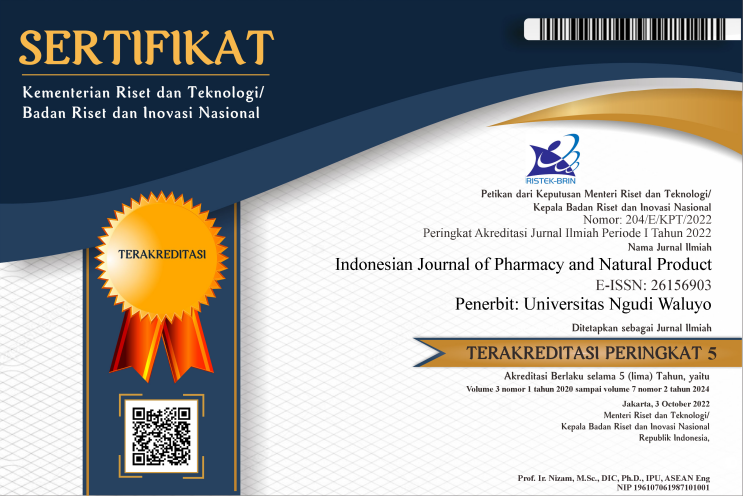Genetic Risk Factors for Idiopathic Urolithiasis: The Causative Role of Genes in Stones Formation
DOI:
https://doi.org/10.35473/ijpnp.v4i2.1302Keywords:
genetic, urolithiasis, stones formationAbstract
Background: The genetic factor of urolithiasis plays an important role in the etiology. Elucidation of responsible genes can lead to better targeted gene therapy and prevention in the future. This article aims to explain various genetic factors that play a role in kidney stone formation Method: A review article on urolithiasis based on a genetic approach is reported to underlie stone formation. A total of 41 abstracts and research articles published by internationally reputed journals were selected based on the keywords genetic factors and urolithiasis. Summary: A deeper understanding of the genetic factors that play a role in the mechanisms of stone formation and advances in molecular and pharmacogenomics have revolutionized diagnosis and treatment, and paved the way for the identification of new therapeutic targets and treatment approaches based on genetic engineering.References
Atar, A., Gedikbasi, A., Sonmezay, E., Kiraz, Z. K., Abbasoglu, S., Tasci, A. I., & Tugcu, V. (2016). Serum paraoxonase-1 gene polymorphism and enzyme activity in patients with urolithiasis. Renal Fail, 38(3), 378–382. https://doi.org/10.3109/0886022X.2015.1136872
Atmoko, W., Raharja, P., Birowo, P., Hamid, A., Taher, A., & Rasyid, N. (2021). Genetic polymorphisms as prognostic factors for recurrent kidney stones: A systematic review and meta-analysis. PloS one, 16(5), e0251235. https://doi.org/10.1371/journal.pone.0251235
Belostotsky, R., Seboun, E., Idelson, G. H., Milliner, D. S., Becker-Cohen, R., Rinat, C., Monico, C. G., Feinstein, S., Ben-Shalom, E., Magen, D., Weissman, I., Charon, C., & Frishberg, Y. (2010). Mutations in DHDPSL are responsible for primary hyperoxaluria type III. Am. J Human Genet, 87(3), 392–399. https://doi.org/10.1016/j.ajhg.2010.07.023
Boassa, D., & Yool, A.J. (2003), Single amino acids in the carboxyl terminal domain of aquaporin-1 contribute to cGMP-dependent ion channel activation. BMC Physiol 3, 12 https://doi.org/10.1186/1472-6793-3-12
Chen Y, Ren X, Li C, Xing S, Fu Z, Yuan Y, Wang R, Wang Y, Lv W (2015) CARD8 rs2043211 polymorphism is associated with gout in a Chinese male population. Cell Physiol Biochem. ;35(4):1394â€1400. https://doi.org/10.1159/000373960
Chou YH, Juo SH, Chiu YC, Juo, S.H.H, Chiu, Y.C., Liu, M.E., Chen, W.C., Chang, C.C., Chang, W.P., Chang, J.G., and Chang, W.C., (2011), A polymorphism of the ORAI1 gene is associated with the risk and recurrence of calcium nephrolithiasis. J Urol.;185(5):1742â€1746. https://doi.org/10.1016/j.juro.2010.12.094
Çoker Gurkan A, Arisan S, Arisan ED, Sönmez NC, Palavan Ãœnsal N. (2013) Association between IL-1RN VNTR, IL-1β -511 and IL-6 (-174, -572, -597) gene polymorphisms and urolithiasis. Urol Int.;91(2):220â€226. https://doi.org/:10.1159/000345786
Feliubadaló, L., Font, M., Purroy, J., Rousaud, F., Estivill, X., Nunes, V., Golomb, E., Centola, M., Aksentijevich, I., Kreiss, Y., Goldman, B., Pras, M., Kastner, D. L., Pras, E., Gasparini, P., Bisceglia, L., Beccia, E., Gallucci, M., de Sanctis, L., Ponzone, A., … International Cystinuria Consortium (1999). Non-type I cystinuria caused by mutations in SLC7A9, encoding a subunit (bo,+AT) of rBAT. Nat Genet, 23(1), 52–57. https://doi.org/10.1038/12652
Giafi, C. F., & Rumsby, G. (1998). Kinetic analysis and tissue distribution of human D-glycerate dehydrogenase/glyoxylate reductase and its relevance to the diagnosis of primary hyperoxaluria type 2. Annals Clin Biochem, 35 (Pt 1), 104–109. https://doi.org/10.1177/000456329803500114
Goldfarb, D. S., Fischer, M. E., Keich, Y., & Goldberg, J. (2005). A twin study of genetic and dietary influences on nephrolithiasis: a report from the Vietnam Era Twin (VET) Registry. Kidney Int, 67(3), 1053–1061. https://doi.org/10.1111/j.1523-1755.2005.00170.x
Guha, M., Bankura, B., Ghosh, S., Pattanayak, A. K., Ghosh, S., Pal, D. K., Puri, A., Kundu, A. K., & Das, M. (2015). Polymorphisms in CaSR and CLDN14 Genes Associated with Increased Risk of Kidney Stone Disease in Patients from the Eastern Part of India. PloS one, 10(6), e0130790. https://doi.org/10.1371/journal.pone.0130790
Hoenderop, J. G., van der Kemp, A. W., Hartog, A., van de Graaf, S. F., van Os, C. H., Willems, P. H., & Bindels, R. J. (1999). Molecular identification of the apical Ca2+ channel in 1, 25-dihydroxyvitamin D3-responsive epithelia. J Biol Chem, 274(13), 8375–8378. https://doi.org/10.1074/jbc.274.13.8375
Joshi, S., Wang, W., & Khan, S. R. (2017). Transcriptional study of hyperoxaluria and calcium oxalate nephrolithiasis in male rats: Inflammatory changes are mainly associated with crystal deposition. PloS one, 12(11), e0185009. https://doi.org/10.1371/journal.pone.0185009
Kahles, F., Findeisen, H. M., & Bruemmer, D. (2014). Osteopontin: A novel regulator at the cross roads of inflammation, obesity and diabetes. Mol.Metab, 3(4), 384–393. https://doi.org/10.1016/j.molmet.2014.03.004
Lin, Y., Mao, Q., Zheng, X., Chen, H., Yang, K., & Xie, L. (2011). Vitamin D receptor genetic polymorphisms and the risk of urolithiasis: a meta-analysis. Urol Int, 86(3), 249–255. https://doi.org/10.1159/000323949
Monico CG, Olson JB, & Milliner DS. (2005), Implications of genotype and enzyme phenotype in pyridoxine response of patients with type I primary hyperoxaluria. Am J Nephrol. ;25(2):183â€188. https://doi.org/10.1159/000085411
Monico CG, Persson M, Ford GC, Rumsby G, Milliner DS. (2002), Potential mechanisms of marked hyperoxaluria not due to primary hyperoxaluria I or II. Kidney Int. ;62(2):392â€400. https://doi.org/10.1046/j.1523-1755.2002.00468.x
Monico, C. G., Rossetti, S., Belostotsky, R., Cogal, A. G., Herges, R. M., Seide, B. M., Olson, J. B., Bergstrahl, E. J., Williams, H. J., Haley, W. E., Frishberg, Y., & Milliner, D. S. (2011). Primary hyperoxaluria type III gene HOGA1 (formerly DHDPSL) as a possible risk factor for idiopathic calcium oxalate urolithiasis. CJASN, 6(9), 2289–2295. https://doi.org/10.2215/CJN.02760311
Okamoto N, Aruga S, Matsuzaki S, Takahashi S, Matsushita K, & Kitamura T.(2007) Associations between renal sodium-citrate cotransporter (hNaDC-1) gene polymorphism and urinary citrate excretion in recurrent renal calcium stone formers and normal controls. Int J Urol.;14(4):344â€349. https://doi.org/10.1111/j.1442-2042.2007.01554.x
Pearle, M. S., Goldfarb, D. S., Assimos, D. G., Curhan, G., Denu-Ciocca, C. J., Matlaga, B. R., Monga, M., Penniston, K. L., Preminger, G. M., Turk, T. M., White, J. R., & American Urological Assocation (2014). Medical management of kidney stones: AUA guideline. J. Urol, 192(2), 316–324. https://doi.org/10.1016/j.juro.2014.05.006
Relan, V, Khullar, M, Singh, SK, and Sharma, SK (2004). Association of vitamin d receptor genotypes with calcium excretion in nephrolithiatic subjects in northern India. Urol Res 32 (3) 236-240 https://doi.org/10.1007/s00240-004-0414-x
Rendina, D., Esposito, T., Mossetti, G., De Filippo, G., Gianfrancesco, F., Perfetti, A., Formisano, P., Prié, D., Strazzullo, P., 2012. A Functional Allelic Variant of the FGF23 Gene Is Associated with Renal Phosphate Leak in Calcium Nephrolithiasis. J. Clin. Endocrinol. Metab. 97, E840-4. https://doi.org/10.1210/jc.2011-1528
Renkema, K. Y., Lee, K., Topala, C. N., Goossens, M., Houillier, P., Bindels, R. J., & Hoenderop, J. G. (2009). TRPV5 gene polymorphisms in renal hypercalciuria. Nephrology, dialysis, transplantation : official publication of the European Dialysis and Transplant Association - European Renal Association, 24(6), 1919–1924. https://doi.org/10.1093/ndt/gfn735
Romero, V., Akpinar, H., & Assimos, D. G. (2010). Kidney stones: a global picture of prevalence, incidence, and associated risk factors. Rev Urol, 12(2-3), e86–e96.
Rungroj, N., Sudtachat, N., Nettuwakul, C., Sawasdee, N., Praditsap, O., Jungtrakoon, P., Sritippayawan, S., Chuawattana, D., Borvornpadungkitti, S., Predanon, C., Susaengrat, W., & Yenchitsomanus, P. T. (2012). Association between human prothrombin variant (T165M) and kidney stone disease. PloS one, 7(9), e45533. https://doi.org/10.1371/journal.pone.0045533
Smith J, Mattoo TK, Stapleton FB. 2010, Patient information: Kidney Stones in children. online. http://www.uptodate.com/patients/content/topic.do?topicKey=~W7Wuul5gemj5LrR
Sorokin, I., Mamoulakis, C., Miyazawa, K., Rodgers, A., Talati, J., & Lotan, Y. (2017). Epidemiology of stone disease across the world. World J Urol, 35(9), 1301–1320. https://doi.org/10.1007/s00345-017-2008-6
Telci, D., Dogan, A. U., Ozbek, E., Polat, E. C., Simsek, A., Cakir, S. S., Yeloglu, H. O., & Sahin, F. (2011). KLOTHO gene polymorphism of G395A is associated with kidney stones. Am J Nephrol, 33(4), 337–343. https://doi.org/10.1159/000325505
Thorleifsson, G., Holm, H., Edvardsson, V., Walters, G. B., Styrkarsdottir, U., Gudbjartsson, D. F., Sulem, P., Halldorsson, B. V., de Vegt, F., d'Ancona, F. C., den Heijer, M., Franzson, L., Christiansen, C., Alexandersen, P., Rafnar, T., Kristjansson, K., Sigurdsson, G., Kiemeney, L. A., Bodvarsson, M., Indridason, O. S., … Stefansson, K. (2009). Sequence variants in the CLDN14 gene associate with kidney stones and bone mineral density. Nat. Gen, 41(8), 926–930. https://doi.org/10.1038/ng.404
Torres, R. J., & Puig, J. G. (2007). Hypoxanthine-guanine phosophoribosyltransferase (HPRT) deficiency: Lesch-Nyhan syndrome. Orphanet J Rare Dis, 2, 48. https://doi.org/10.1186/1750-1172-2-48
Torres, R. J., Prior, C., & Puig, J. G. (2007). Efficacy and safety of allopurinol in patients with hypoxanthine-guanine phosphoribosyltransferase deficiency. Metabolism: clinical and experimental, 56(9), 1179–1186. https://doi.org/10.1016/j.metabol.2007.04.013
Tsuji, H., Shimizu, N., Nozawa, M., Umekawa, T., Yoshimura, K., De Velasco, M. A., Uemura, H., & Khan, S. R. (2014). Osteopontin knockdown in the kidneys of hyperoxaluric rats leads to reduction in renal calcium oxalate crystal deposition. Urolithiasis, 42(3), 195–202. https://doi.org/10.1007/s00240-014-0649-0
Türk, C., PetÅ™Ãk, A., Sarica, K., Seitz, C., Skolarikos, A., Straub, M., & Knoll, T. (2016). EAU Guidelines on Diagnosis and Conservative Management of Urolithiasis. European Urol, 69(3), 468–474. https://doi.org/10.1016/j.eururo.2015.07.040
Tzou, D. T., Taguchi, K., Chi, T., & Stoller, M. L. (2016). Animal models of urinary stone disease, Int J. Surgery (London, England), 36(Pt D), 596–606. https://doi.org/10.1016/j.ijsu.2016.11.018
Vezzoli, G., Terranegra, A., Aloia, A., Arcidiacono, T., Milanesi, L., Mosca, E., Mingione, A., Spotti, D., Cusi, D., Hou, J., Hendy, G. N., Soldati, L., GENIAL network (Genetics and Environment in Nephrolithiasis Italian Alliance), Paloschi, V., Dogliotti, E., Brasacchio, C., Dell'Antonio, G., Montorsi, F., Bertini, R., Bellinzoni, P., … Del Prete, D. (2013). Decreased transcriptional activity of calcium-sensing receptor gene promoter 1 is associated with calcium nephrolithiasis. J Clinl Endocrinol Metab, 98(9), 3839–3847. https://doi.org/10.1210/jc.2013-1834
Vezzoli, G., Terranegra, A., Arcidiacono, T., Biasion, R., Coviello, D., Syren, M. L., Paloschi, V., Giannini, S., Mignogna, G., Rubinacci, A., Ferraretto, A., Cusi, D., Bianchi, G., & Soldati, L. (2007). R990G polymorphism of calcium-sensing receptor does produce a gain-of-function and predispose to primary hypercalciuria. Kidney Int., 71(11), 1155–1162. https://doi.org/10.1038/sj.ki.5002156
Williams, E. L., Acquaviva, C., Amoroso, A., Chevalier, F., Coulter-Mackie, M., Monico, C. G., Giachino, D., Owen, T., Robbiano, A., Salido, E., Waterham, H., & Rumsby, G. (2009). Primary hyperoxaluria type 1: update and additional mutation analysis of the AGXT gene. Human Mut, 30(6), 910–917. https://doi.org/10.1002/humu.21021
Xiao, X., Dong, Z., Ye, X., Yan, Y., Chen, X., Pan, Q., Xie, Y., Xie, J., Wang, Q., & Yuan, Q. (2016). Association between OPN genetic variations and nephrolithiasis risk. Biomed Rep, 5(3), 321–326. https://doi.org/10.3892/br.2016.724
Xu Y, Zeng G, Mai Z, Ou L. (2014), Association study of DGKH gene polymorphisms with calcium oxalate stone in Chinese population. Urolithiasis. ;42(5):379â€385. https://doi.org/10.1007/s00240-014-0692-x
Xu, C., Song, R. J., Yang, J., Jiang, B., Wang, X. L., Wu, W., & Zhang, W. (2013). Klotho gene polymorphism of rs3752472 is associated with the risk of urinary calculi in the population of Han nationality in Eastern China. Gene, 526(2), 494–497. https://doi.org/10.1016/j.gene.2013.06.001
Yasui, T., Okada, A., Urabe, Y. Usami,M., Mizuno, K., Kubota, Y., Tozawa, K., Sasaki, S., Higashi, Y., Sato, Y., Kubo, M., Nakamura, Y., Matsuda, K., & Kohri. K., (2013), A replication study for three nephrolithiasis loci at 5q35.3, 7p14.3 and 13q14.1 in the Japanese population. J Hum Genet 58, 588–593. https://doi.org/10.1038/jhg.2013.59



